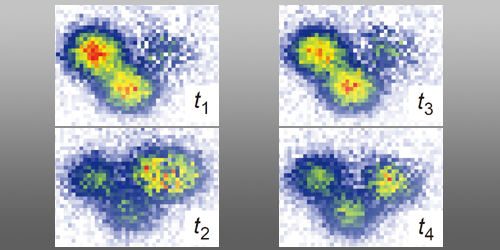A Jiggling Ultracold Atomic Gas Simulates Spin Dynamics
Recently, researchers have begun using ultracold atomic gases to simulate phenomena that are difficult to study in their natural environments. Using electromagnetic fields, for example, they can orchestrate interatomic interactions that are analogous to interactions in condensed-matter systems, which they can then study with greater experimental control than the real examples allow. Now David Wilkowski of Nanyang Technological University in Singapore and colleagues use an ultracold atomic gas to simulate a condensed-matter system’s spin dynamics [1].
Wilkowski’s team cools a gas of strontium-87 atoms to 30 nK. Then, using three convergent laser beams, they drive the gas through various transitions until the atoms populate two so-called dark states, in which quantum mechanics forbids the atoms from undergoing spontaneous emission.
The relationship between the two dark states parallels the relationship between opposite quantum spin states: as particles with different spins move differently in a magnetic field, so atoms in different dark states move differently in the laser field. As the atoms collectively evolve between different superpositions of these dark states, their interaction with the field induces a “jiggling” motion of their center of mass. This interaction reproduces the phenomenon of spin-orbit coupling, with the dark state representing spin and the atoms’ motion representing orbital angular momentum. This analogy with spin systems goes further: in the experiment, the direction of the gas’s jiggling motion is perpendicular to its average momentum—a velocity-momentum relationship that parallels the spin Hall effect in condensed-matter systems, in which a charge current induces a perpendicular spin current. Next, the researchers plan to use more complex interactions between atoms and laser fields to mimic high-energy particle systems.
–Sophia Chen
Sophia Chen is a freelance science writer based in Columbus, Ohio.
References
- M. Hasan et al., “Wave packet dynamics in synthetic non-Abelian gauge fields,” Phys. Rev. Lett. 129, 130402 (2022).




